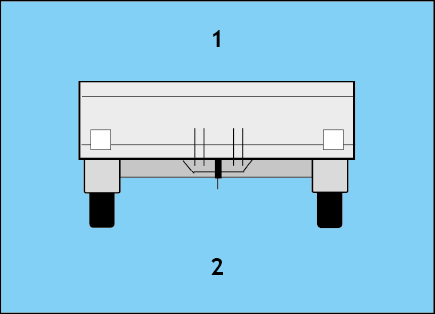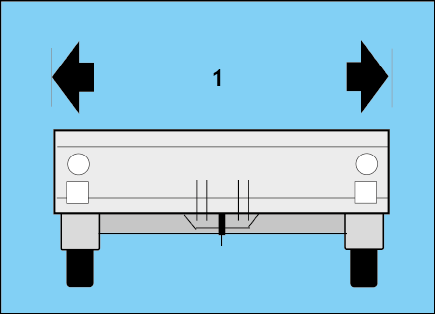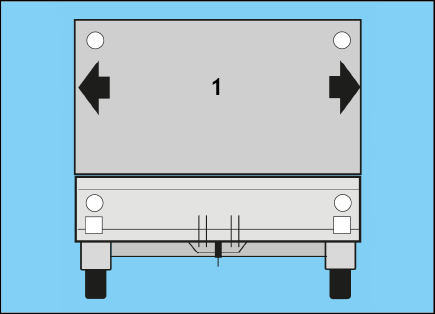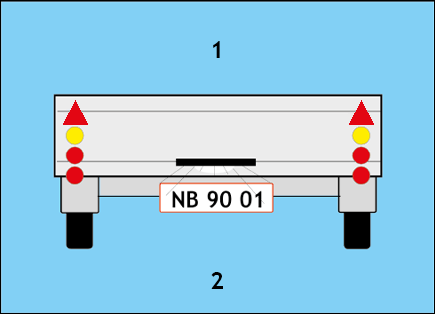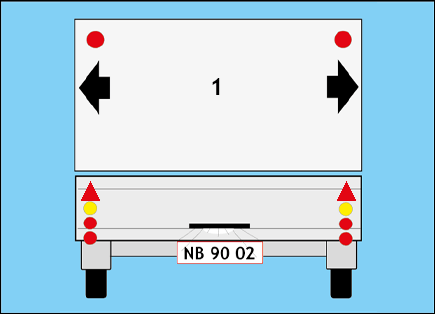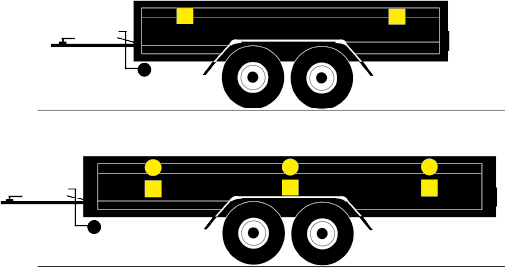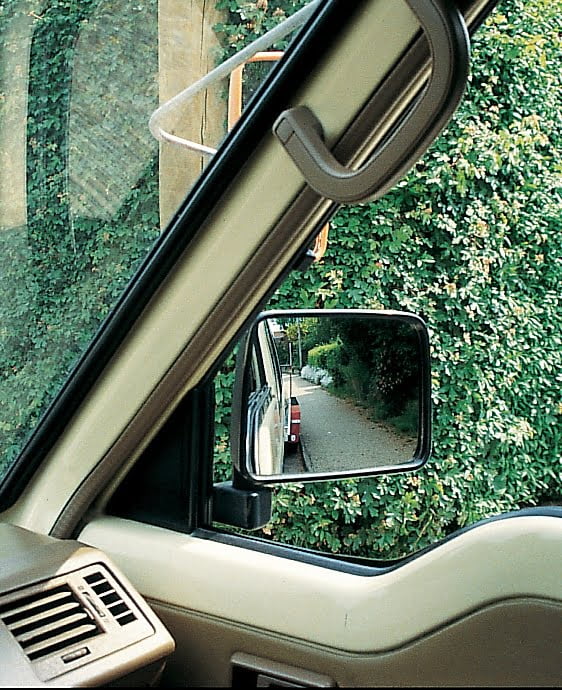Trailer
Driving school
theory book
for category B+ and BE
Lights and reflectors.
A trailer may only be equipped with mandatory or authorised lights and reflectors. Mandatory reflectors must be approved.
1. Front view of the trailer.
2. All trailers must have at least 2 white reflectors.
Lights and reflectors on the front of the trailer:
All trailers, regardless of width, must be fitted with at least 2 white front reflectors.
1. Over 1.60 metres. 2 white position lights.
Extra reflectors: Allowed, but must be placed symmetrically.
Trailers with a width of more than 1.60 metres. Must be equipped with at least 2 forward-facing white position lights.
1. Over 2.10 metres. 2 white marker lights.
Trailers with a width over 2.10 metres: Must be equipped with at least 2 white forward-facing marker lamps. Marker lights must be positioned as high as possible, taking into account the design of the trailer. The purpose is to give other road users an impression of the size of the trailer. Trailers can be equipped with additional forward-facing indicators. Both position lights and marker lights must be clearly visible in the dark at a distance of 300 metres. Lens and reflectors may be combined.
1. Rear view of the trailer.
2. Rear lights on all trailers.
Lights and reflectors at the back: All trailers, regardless of width, must be equipped with rear lights and reflectors at the rear, just like on a car, except for the shape of the reflectors, which we'll repeat: Trailers must be equipped with at least 2 rear lights that shine red and are visible from a distance of 300 metres. Number plate lighting must be provided so that the plate is legible in the dark from a distance of 20 metres. Trailers must also be equipped with at least 2 rear stop lamps that glow bright red when braking and at least 2 rear direction indicators that flash amber and are clearly visible in sunlight. Finally, trailers must be equipped with 2 rearward-facing red triangular reflectors.
1. trailers over 2.10 metres must have marker lights.
If the trailer is wider than 2.10 metres: It must also be fitted with at least 2 rearward-facing end-outline marker lamps which emit red light of the same intensity as the rear lamps and which, taking into account the design of the trailer, must be positioned as high as possible. End-outline marker lamps may be mounted on the sides of the trailer. These marker lamps may be fitted to the trailer as an option if it is wider than 1.80 metres. It is permitted to equip the trailer with additional indicators, lights and reflectors at the rear of the trailer, as long as they are positioned symmetrically, bearing in mind that lights in a pair must be of the same colour and brightness. The lights behind the trailer can be grouped together.
§ Lights and reflectors on the side:
All trailers, regardless of length, must be fitted with amber side reflectors on both sides. Trailers longer than 6 metres must also be equipped with side marker lights on both sides. They must be directed to the side and illuminated with amber light that is visible from a distance of 300 metres.
Mandatory amber side reflectors must be approved, labelled and distributed on the sides of the trailer. Side reflectors can be replaced by amber side marker lights that are clearly visible from a distance of at least 300 metres without dazzling. Newer trailers must be equipped with side reflectors and, if the length of the trailer exceeds 6 metres, also with side marker lamps (side reflectors and side marker lamps may be combined). The coupling device must be included in the length of the vehicle.
§ Auxiliary (or "auxiliary") lights:
Trailers can also be equipped with auxiliary lights according to the user's needs as follows: 1 or 2 work lights intended to illuminate a work site, e.g. an excavation.
- Searchlight, which is a swivelling floodlight designed to briefly illuminate a road name, house number, etc. (mostly seen on police and emergency vehicles).
- 1 or 2 rear fog lamps intended for driving in dense fog or other highly visibly unfavourable weather conditions.
- 1 or 2 rear lights intended to illuminate the roadway behind the vehicle combination when reversing in the dark. It must only be possible to switch on the rear lights when the vehicle is in reverse gear.
Remember that auxiliary lights may only be used for the specific purpose for which they are intended.
Lights etc.
Periodically check the following conditions for lights and reflectors:
- That all lights can shine.
- That the stop lights are significantly brighter than the rear lights.
- The indicators must be clearly visible in sunlight.
- That number plate lights have a white light that can illuminate the rear number plate so that it can be clearly read from a distance of at least 20 metres.
- That lights in a pair of lights have the same colour and brightness.
- That rear-facing reflectors are triangular and placed with the tip facing upwards.
- Side reflectors/side marker lights are fitted on both sides of the trailer.
- Ensure that lenses and reflectors are intact and clean.
Recognise the signs of failure:
Lights that do not work or work incorrectly can be caused by a fault in the electrical connector between the car and trailer, e.g. poor connection.
If the indicators are flashing significantly faster than usual, this is usually a sign that one or more indicators are not working.
For blind coupling, the electrical system must be a 12-volt system and the transfer of electricity from the car to the trailer must be carried out using either a 7-pin or 13-pin standard plug (you can "redesign" with a plug-in adapter). The cable must be positioned so that it does not wear, pinch or drag on the road surface.
Mirrors:
The towing vehicle must be equipped with an exterior side mirror on the left side. The mirror must have a reflective surface of at least 70 cm2 for a flat mirror and at least 50 cm2 for a convex mirror. Convex means that the mirror surface curves outwards and reflects a larger angle backwards to the side. A disadvantage, however, is that the subject in the mirror appears somewhat diminished and it takes a little practice to get used to this "optical illusion". If the trailer or its load reduces the rearward view in the interior rear-view mirror (rear-view mirror), the vehicle must also be equipped with an exterior side mirror on the right-hand side of a similar size.
The mirrors must also be of such a size, shape and position that the driver can use them alone to orientate himself sufficiently to the rear along the sides of the vehicle combination.
Test your knowledge
Cat. B+ and BE - Section 4
Select the questions you think are the right ones.
